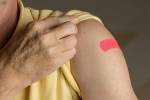New HPV, meningitis vaccines recommended for kids and adults
New vaccines for meningococcal type B and HPV and are among the updates to the immunization schedule published for children and adults.
The Advisory Committee on Immunization Practices, known as ACIP, makes the updates every year. ACIP is a part of the Centers for Disease Control and Prevention.
A number of medical groups, including the American College of Obstetricians and Gynecologists and the American Academy of Family Physicians, have endorsed the new schedules.
One of the biggest changes this year is a new recommendation for MenB, a vaccine that protects against meningococcal serotype B infections, said Dr. Candice Robinson, a member of the childhood and adolescent working group for the ACIP.
Meningococcal serotype B infections are responsible for about one-third of U.S. cases of meningitis, an infection that attacks the lining of the brain and spinal cord. It is fatal in 10 percent to 14 percent of cases and can lead to permanent disability, including hearing loss and loss of limbs.
"Parents need to know about it. ... It strikes quickly, it's unforgiving and it's often deadly," said Dr. Sandra Fryhofer, the American College of Physicians liaison to the ACIP. Parents and young adults should talk with their doctor about whether they should get the vaccine, she added.
For the first time, the schedule includes advice about MenB vaccination even for those who are not at high risk of disease. It applies to certain groups of young people, generally 16 to 23, who might face elevated risk because they will be moving into college dormitories or military barracks.
The immunization schedule recommends one of the new MenB vaccines, Bexsero or Trumenba, for anyone older than 10 who is at increased risk of developing serious meningococcal disease, such as those with sickle cell disease or other conditions that damage the spleen and those with immune problems that could affect their ability to fight off the meningitidis bacteria.
"Providers should discuss with the family the circumstances for that individual child," Robinson said.
Last year's recommendation that all children and adults at elevated risk receive the MenACWY vaccine still stands.
"Getting one does not mean they don't need the other," Robinson said.
New HPV vaccine
Another big change in this year's schedule is that individuals getting the human papillomavirus (HPV) vaccine, which is recommended for girls and boys ages 11 to 12, have another option. A new vaccine product called 9vHPV protects against nine types of the virus.
The other HPV vaccines, 2vHPV and 4vHPV, protect against two and four different HPV types, respectively. All three vaccines prevent infection with types 16 and 18, which are responsible for 66% of cases of cervical cancer. The additional types covered in 9vHPV are responsible for about 14 percent of HPV cancers in females and 4% in males.
The type of HPV vaccine that people receive could depend on what is available in their doctor's office, Robinson said.
Parents might also notice a change in the timing of the HPV vaccine in the full immunization chart, which captures this year's immunization schedule for children from birth to 18.
Children who have been victims of sexual abuse should receive the vaccine at 9 or 10 instead of 11 or 12 because they have a higher risk of HPV. This modification was actually included in the 2015 recommendations but was not represented on the chart, Robinson said. It would actually be fine for children starting at 9 to receive the HPV vaccine if the parents would like them to get it a little earlier, Robinson said.
Although Robinson does not foresee changes in this year's childhood immunization schedule that would be contested by parents, she said, "If a parent has a concern about a vaccine, they should always talk with their provider and they can provide the best information."
Parents who want all the information in this year's childhood immunization schedule can refer to CDC.gov/vaccines for the full chart online, which includes specific recommendations for children in high-risk groups, which are depicted in purple.
However, "if your child is otherwise healthy, the easy-to-read version is a good place to start to see which vaccinations they need," Robinson said. It summarizes recommendations for children from birth to 6 years of age.
Vaccines aren't just for kids
There's also a chart that summarizes the new adult immunization schedule. It is available in an article published in the Annals of Internal Medicine on Monday about the changes, but will soon be on the CDC website.
"It's a neat cheat for patients, nurses, physicians, everyone to refer to," Fryhofer said. "As time has gone on, adult immunization has got more complicated as we have more vaccines for adults."
Some of the changes for adults are similar to the ones for children and adolescents. Adults at high risk of meningococcal B infection are also candidates for the new MenB vaccine, including those with spleen damage or traveling to areas where there are meningococcal outbreaks.
In addition, the HPV vaccine is recommended for women between 19 and 26 and men between 19 and 21, or up to 26 years old among men having sex with men. Now those groups have the option of the 9vHPV product. Even those who have already finished the full three-dose course of 2vHPV or 4vHPV may want to talk with their doctor about whether to get 9vHPV, Fryhofer said.
There is also a change to the timing of the pneumococcal vaccines.
In 2015, it was recommended that all adults 65 get PCV13 (Prevnar 13) and PPSV23 (Pneumovax), which protect against different types of Streptococcus pneumonia bacteria, between 6 and 12 months apart from each other. The new schedule changes the spacing to at least one year, because research has found it is associated with a better immune response.
"It's a win-win" because Medicare will only cover vaccines that are 12 months apart, Fryhofer said.
The pneumococcal vaccines are also recommended for a number of high-risk groups younger than 65, including people who smoke or have certain types of chronic heart or lung disease. The inclusion of these groups has not changed since last year.
The article describing the new adult immunization schedule calls out the low rates of vaccination, particularly among groups of people who stand to benefit the most from getting vaccinated. During the 2012-2013 flu season, only 46 percent of patients with lung disease and 50 percent of patients with heart disease received the flu vaccine. The article reminds physicians to assess their patients' vaccination status and urge them to get the appropriate immunizations.
"Vaccination is important, and vaccines are not just for kids, adults need them, too," Fryhofer said.
There is information on the CDC website about additional vaccines that are not included in the general immunization schedules but are recommended for certain groups of people, such as yellow fever for travelers and anthrax for members of the military.




























